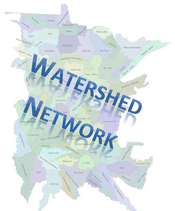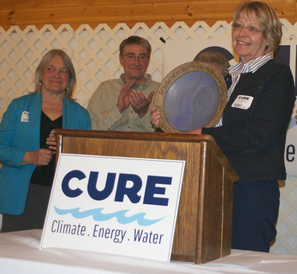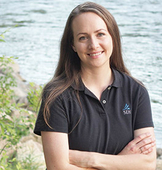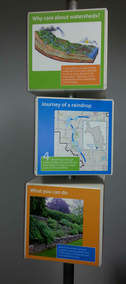April 2018

It
started in 1998 with 17 volunteers monitoring the health of 22 streams sites
in southeast Minnesota. Today there are more than 400 volunteers and 500
stream sites across Minnesota. The data they collect are indispensable to the
Minnesota Pollution Control Agency (MPCA). Photo: Ron Revier lowers a Secchi disk in Foot Lake in Willmar.
The MPCA
is celebrating the 20th anniversary of the Citizen Stream Monitoring Program
this year, and produced a video program to
recognize volunteers and their contributions to cleaner water. For many
volunteers, their observations and opportunities to bring attention to
streams are just as important as the data collected.
One of
the volunteers in the video program is Richard Betz, a nine-year monitor on a
Flute Reed River site in Cook County. “I can report things like this slumping bank
I’ve got here. If I wouldn’t have been here, the county soil and water
wouldn’t know about this,” he said.
With
69,000 miles of streams and more than 14,000 lakes in Minnesota, the MPCA
cannot monitor all that water on a continual basis. For some lakes and
streams, citizen data are the only data available. For all waterbodies
monitored, the data are crucial to tracking long-term trends in water
quality, to see if lake and stream health is getting better or worse over
time.
News release with link to video: https://www.pca.state.mn.us/featured/20-years-400-volunteers-and-priceless-information-about-water-quality
Video: https://www.youtube.com/watch?v=7dYpE66xsUI.
Back to top
|

The Watershed Professionals Network spring program
is scheduled for 9:30 a.m.-noon Thursday, April 26 at the Mankato Pizza Ranch, 1551 Tullamore St. This is a great opportunity for watershed
organization and agency staff to network and learn about interesting topics.
The program line-up includes:
-
9:30-9:45 – Welcome
-
9:45-10:15
– From turbidity to TSS, an update on and current status of the Minnesota and
Greater Blue Earth rivers TMDLs for Total Suspended Solids, Paul Davis, MPCA.
-
10:25-11:15
– New focus for CWA Section 319 grants, invitation for pilot projects, Cindy Penny and Greg
Johnson, MPCA.
- 11:15-11:45
– Networking and updates: Minnesota River basin sediment reduction strategy,
WRAPS/1W1P, Minnesota River Congress.
-
11:45-12:30
– Lunch (Pizza Ranch buffet $10.38 tax/beverage included)
Launched
in 2009, the network provides a monthly e-newsletter and hosts meetings in the
spring and fall. For more information contact Forrest Peterson, forrest.peterson@state.mn.us, 320-979-1776.
Back to top
|
 Kylene Olson, long-time executive director of the Chippewa River Watershed Project, is stepping down after a 20-year career there since its inception. The project's board of directors, composed of county commissioners from Chippewa, Pope, Douglas, Swift, Stevens, Grant and Kandiyohi counties, are looking for a replacement. Long-time Watershed Specialist Jennifer Hoffman plans to continue in her present position.
As reported in the West Central Tribune, the Chippewa River Watershed Project became a pioneer in identifying what causes water quality problems, and how to address them with the support of cooperating landowners on a voluntary basis. The data collected has made the watershed one of the most understood in the state. Funding for projects has totaled about $17.5 million from grants, loans, and local matches.
At her future new home site on a sister’s ranch near Hot
Springs, South Dakota Kylene says she can see the Black Hills from the front door. Cattle and
horses, including her own, roam the 1,200-acre ranch near Buffalo Gap. After
fixing up and selling her house in Watson, a vacation to Glacier National Park
in July with her sisters, Kylene hopes to be in her new home sometime in
August. Of Kylene’s four siblings, three sisters live in Montevideo, Coon Rapids, and near
Glacier Park, and a brother lives in St. Paul.
The watershed’s board of directors will be advertising soon
for a replacement. For more information contact Jennifer Hoffman at
320-321-1718. Change Is Around The Bend For Chippewa River Project, West Central Tribune story by Tom Cherveny, March 24, 2018. Photo: Kylene Olson received the River Keeper award in 2013 from Clean Up the River Environment. Looking on are past recipients Audrey Arner and Tom Cherveny.
Back to top
|

A traveling exhibit exploring
Minnesotans’ emotional connections with water will be on display at the
Historical and Cultural Society of Clay County through June 17. “We Are Water Minnesota” employs a variety of
multimedia and hands-on displays to both inform viewers and celebrate the role
of water in what makes Minnesota such a special place.
The museum
is located in Moorhead, Minn., on the banks of the Red River of the North. In
partnership with the Moorhead-based nonprofit River Keepers, the museum will
create a series of panels about Moorhead’s history related to water and ecology
of the Red River watershed.
The Red
River Valley is the defining feature of northwest Minnesota. Historically a
tallgrass prairie, the valley is the flattest, driest, most fire-prone region
of Minnesota. It is also prone to seasonal and event-based flooding.
From fishing
to farming to flooding, there are many water stories to tell in Moorhead.
Listen to stories from parents, children, fishers, famers, indigenous
Minnesotans, immigrants to Minnesota, water professionals, and people who just
love to be out on the water. Visitors can add their stories to the exhibit and
read each other’s.
Back to top
|
 Her career as a water resources engineer was inspired by her 4-H earth science project in Nicollet County, but Rachel Pichelmann still thinks about the 4-H communications project too.
Between her junior and senior years in high school, Pichelmann developed a 4-H project with data she collected while volunteering in the Citizen Stream Monitoring Program with the Minnesota Pollution Control Agency. The project sparked her interest in engineering and the environment.
Those skills help the engineer at Short Elliott Hendrickson Inc. when she collaborates with agencies, clients and the public on projects throughout the Midwest. She enjoys working on multi-discipline teams, assisting clients with identifying and understanding flood risk, and developing alternatives which may reduce this risk.
The purple ribbons the project earned her at the Minnesota State Fair were not her last awards. In 2017, she was presented with two Young Engineer of the Year awards, one from the Minnesota Federation of Engineering, Science, and Technology Societies and the other from the Society of American Military Engineers. - U of M Extension Source magazine, Fall 2017
Back to top
|
 Spring is here and it is time to gear up for Earth Month activities, neighborhood clean-ups and environmental fairs. Did you know that the Minnesota Pollution Control Agency has free resources to use including display banners and a variety of environmental fact sheets? Call 651-757-2120 today to reserve your materials from the Living Green Resource Center.
The MPCA has publications available for free download. Minnesota residents may also request printed copies of these publications while supplies last. To order copies, contact us by e-mail at resourcecenter.pca@state.mn.us or you may also reach us by phone at 651-757-2120.
The MPCA also offers display materials for use by local units of government, community groups, and educators. These items are available to Minnesota residents for short-term loan (generally, two weeks or less). There is no charge to borrow our display materials. However, borrowers must accept responsibility for displaying items in a secure area and returning them in good condition. The MPCA cannot mail display items, so borrowers must arrange to have the items picked up and returned at our St. Paul office. It is best to reserve displays 4-6 weeks before they are needed.
• To reserve available display items, please contact us by phone at 651-757-2120. You may also reach us by e-mail at resourcecenter.pca@state.mn.us.
• Banners are 6 feet tall, 3 or 4 feet wide, and freestanding. They are lightweight and collapse into a portable canvas bag.
Back to top
|
New Minnesota River Congress website previews May 17 event in Mankato
The new Minnesota River Congress website debuts with details about the 10th congress scheduled for
Thursday, May 17 at the Kato Ballrooom in Mankato. About 75 people
attended the ninth Congress Nov. 16 at Jordan, reviewing progress on
resolutions, interest network teams and board activities. The board
met Tuesday,
March 27 in Henderson at the Community Center. Resolutions approved at previous
meetings include: Building soil organic matter, flow control in
streams, connecting waterways, funding Minnesota River Basin Data Center,
civic engagement, Granite Falls fish passage and whitewater park, state
river trails, and paddler access. For more information contact Scott Sparlin, sesparlin@gmail.com,
507-276-2280.
CURE 26th annual member meeting April 21
The 26th annual membership meeting for Clean Up the River Environment is scheduled for 10 a.m.-3:30 p.m. Saturday, April 21 at the community center in Maynard, 341 Cynthia St. The day will begin with refreshments and networking, followed by a business meeting at 11 a.m. when board members will be elected. Following lunch, at 1 p.m. a 'people's assembly' will work on "creating a people-centered vision for rural Minnesota where everybody is in and nobody is out." Qualified candidates for the board election are needed, with nominations due April 14. Register for the meeting online or by contacting the CURE office by email to peg@cureriver.org, or calling 320-269-2984.
Back to top

After one year of a five-year groundwater management plan in
central Minnesota, the DNR and a citizen advisory team have begun to identify
steps to sustainably manage groundwater in the area. The Bonanza Valley Groundwater
Management Area includes portions of western Stearns, eastern Pope, and
northern Kandiyohi counties. In recent years increasing irrigation for crops
has caused groundwater levels to drop, and the sand-gravel subsurface can cause
nitrates to infiltrate.
At a biennial meeting March 22 in Glenwood, the
Implementation Advisory Team reviewed a list of implementation activities in
phases over five years. First-year activities include monitoring of stream
flow, wetlands, lake levels, and groundwater levels; estimates of non-permitted
groundwater use; modeling; assessing negative impacts; improving data access;
and education and outreach.
In coming years the DNR will be collecting and analyzing
additional information to determine if total permitted groundwater use is
having a negative impact on surface waters and aquifers in the area. DNR will
continue to work with individuals, communities, and businesses throughout the
implementation of the action plan. For more information contact Mark Hauck,
project manager with the DNR Division of Ecological and Water Resources, Mark.Hauck@state.mn.us, 320-223-7846.
Back to top
|
 Registration is open for the DNR workshop, "Fundamentals of River Science: Applied Geomorphology and Ecology," June 11-15 in Marshall. This is one of a series of workshops teaching basic functions and processes of streams and rivers; stream classification; field surveying; assessment and monitoring of channel morphology, stability, and sediment transport; and restoration where natural, stable stream reaches are used as templates for design.
This course discusses the fluvial geomorphological processes involved in creating and maintaining a stream’s shape and stability, as well as the fundamental hydrology and hydraulics of rivers. It is designed for natural resource professionals whose work involves rivers and streams as well as those engaged in watershed-wide resource management issues. They include lectures and field applications where students are required to complete fieldwork, data analysis, and present their findings.
More information and registration details are available online, or by contacting Amy Childers, 218-739-7576 ext. 233, Amy.R.Childers@state.mn.us.
Back to top
|
The Minnesota Agroforestry Institute will be held June 19-21 at the U of M Southwest Research and Outreach Center (SWROC), 23669 - 130th St., Lamberton. Time and tours are Tuesday, June 19, 8 a.m.-7 p.m., Wednesday, June 20; 8 a.m.-6 p.m.; and Thursday, June 21, 8 a.m.-12 p.m.
The training includes classroom workshops and on-farm visits of Agroforestry practices in the field. Learn more about the Agroforestry practices of windbreaks, alley cropping, silvopasture, riparian buffers and forest farming in Minnesota. Agroforestry practices can benefit farmers and woodland owners and can bring trees back in the agricultural landscape where they are most appropriate. The target audience is natural resource and agricultural consultants/professionals, farmers and school teachers.
The participants will work in small groups to gain hands-on practice in agroforestry design based on the needs of a working farm case study. As a result of this training, participants will help to enhance Minnesota landowner adoption of agroforestry practices. Learn more online. Register online. The $100 registration fee covers the costs for three lunches, two dinners and refreshments. It is approved for SAF CEUs. Certified Crop Advisor CEUs have been applied for. Teacher CEUs are also available.
Back to top
Extension seeks soil health specialist
The MN Office for Soil Health (at the University of Minnesota) is seeking to hire an Extension Soil Health Specialist. On-campus interviews for the top three candidates were March 22, March 27, and the third scheduled for April 12. Stakeholders inside and outside the U are encouraged to participate in interview seminars and meetings, and to provide feedback about the candidates. The interview schedules and candidate information are available on the Soil Health Specialist position web page with webinars (live stream and recordings), and link to a form to share evaluation comments.
Lessard-Sams funding round opens April 1
The Lessard-Sams
Outdoor Heritage Council funding round opened April 1 for Fiscal Year 2020 projects. Applicants will then have until May 31 to
complete their proposals for Clean Water Fund grants. Check the council’s website for updates.
Reminder: LCCMR proposals due April 11
Proposals
are due April 11 for funding from the Legislative-
Citizen Commission on Minnesota Resources. This commission funds
projects of all sizes that aim to protect, conserve, preserve, and enhance
Minnesota’s air, water, land, fish, wildlife, and other natural resources.
About $59 million is anticipated to be available for projects beginning July 1,
2019.
After 29 years, it's '30' for EPA’s Nonpoint Source News-Notes
After 102 issues and 29 years, the U.S. Environmental Protection Agency is ceasing publication of Nonpoint Source News-Notes. No. 102-March 2018 is the final issue. (In old-time newspaper jargon '30' signified the end of a story, typed on real paper.) "News Notes has always been about you, our readers. Your dedicated and creative water quality protection efforts across our country have constantly amazed and inspired us. Thank you for allowing us to be a part of it." - Don Waye (EPA) and Kary Phillips (Tetra Tech, Inc.), co-editors.
DNR plans lake basin restoration at Blue Mounds State Park
The Dept. of Natural Resources is accepting public comments until April 25 on a plan to address conditions left by natural disasters that occurred between June and July, 2014. It resulted in a failed dam and damages, including the drained basin that was known as Lower Mound Lake, located within Blue Mounds State Park near Luverne. The proposed project includes removal of the remaining structures of the failed dam and restoration of Lower Mound Lake Basin to a natural stream. Public comments can be submitted electronically at Environmentalrev.dnr@state.mn.us or via mail to Kathy Metzker, EAW Project Manager Environmental Review Unit DNR Division of Ecological and Water Resources, Box 25 500 Lafayette Road St. Paul, MN 55155-4025. The EAW and attachments are available for public review online, at the following locations, or by calling 651-259-5694.
- DNR Library, 500 Lafayette Road, St. Paul.
- DNR Southern Region Headquarters, 21371 State Highway 15 South, New Ulm.
- Hennepin County – Minneapolis Central Library, Government Documents, 2nd floor, 300 Nicollet Mall, Minneapolis.
- Marshall-Lyon County Library, 201 C Street, Marshall.
- Rock County Community Library, 201 West Main Street, Luverne.
Bois de Sioux River Watershed WRAPS and TMDL on public notice
The Bois de Sioux River Watershed WRAPS and TMDL
reports went on public notice April 2 through May 2. The reports are posted on the Bois de
Sioux River Watershed web page. The public notice for these reports were published in the State Register on April 2 and
posted on the MPCA Public Notice web page. The Draft/pending
projects web page has been updated with the public notice dates.
The Bois de Sioux River Watershed includes the
drainage areas of Lake Traverse and the Bois de Sioux River. The Bois de Sioux
and Otter Tail Rivers converge to form the headwaters of the Red River of the
North. The watershed covers 2,908 square kilometers (718,685 acres) in areas of
Otter Tail, Grant, Wilkin, Big Stone, and Traverse counties in Minnesota,
Roberts County in South Dakota, and Richland County in North Dakota.
Back to top
|